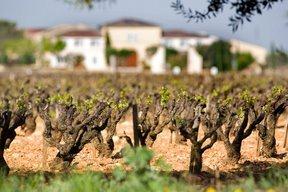2004 Château de Beaucastel Châteauneuf-du-Pape Châteauneuf-du-Pape Rhône France Wine Tasting Note
13811 Views
|
2004
Château de Beaucastel (Châteauneuf-du-Pape)
Time has been kind to this wine, as it has really come on strong with bottle age. Crisp, classic and fresh, with a kirsch, spice and herbed, tannic profile. Classic, with loads of bright, clean red fruits, age it a few more years for additional nuance, or pop a cork if you prefer more of a classic, bite. 5,943 Views Tasted May 17, 2017Spicy red cherries, strawberry, pepper, black raspberry and gamey notes along with fresh Provencal herb aromatics open to a medium to full bodied, bright, fresh Chateauneuf du Pape that is dominated by spicy, red berries. This is still young, with luck, time could add more richness to the wine. 7,868 Views Tasted Oct 21, 2012 |

When to Drink Chateau Beaucastel, Anticipated Maturity, Decanting Time
Chateau Beaucastel is a much better wine with age. Young vintages can be decanted for 2-3 hours, give or take. This allows the wine to soften and open its perfume. Older vintages might need very little decanting, just enough to remove the sediment.
Chateau Beaucastel is better with 6-10 years of bottle age. Of course, that can vary slightly, depending on the vintage. In the best vintages, the wine should be consumed within 10-35 years after the vintage.
Serving Beaucastel with Wine, Food, Pairing Tips
Beaucastel is best served at 15.5 degrees Celsius, 60 degrees Fahrenheit. The cool, almost cellar temperature gives the wine more freshness and lift.
Beaucastel Rouge is best served with all types of classic meat dishes, veal, pork, beef, lamb, duck, game, roast chicken, roasted, braised, stewed, grilled dishes, sausage, tomatoes, and cassoulet. Beaucastel Rouge is also good with Asian dishes, hearty fish courses like tuna, mushrooms, and pasta.
The white wine of Beaucastel is best served with a myriad of different seafood dishes, shellfish, crab, lobster, sushi, sashimi, chicken, pork, and veal, as well as Asian cuisine and cheese.
Other wines from the Perrin family.
The Perrin family also maintains a partnership in California with Robert Haas called Tablas Creek. Formed in 1989, the California winery focuses on producing Rhone-style wine with both red and white Rhone varietals.
In 2013, the Perrin family entered into a partnership with Brad Pitt and Angelina Jolie to produce Miraval, an organic Rose' wine from their Provencal estate. Miraval also produces 2 white wines, a blend of Grenache Blanc and Rolle, as well as a wine from 100% Rolle. Needless to say, Miraval is now the world's most popular Rose and wine from the Cotes de Provence.
In 2015, Miraval became the first rose' as well as the first wine in the entire Provence appellation to add anti-counterfeiting measures to their bottle. To prevent the type of forgeries that anything to do with Brad Pitt and Angelina Jolie attracts, Miraval comes in a unique curve-shaped bottle. The bottle is also etched with the word Miraval at the bottom of the bottle.
Starting with the 2009 vintage, Beaucastel became one of the first wines outside of Bordeaux to be sold on the Place de Bordeaux by Bordeaux negociants. The Perrin family also produces one of the best red and white wines from their 30 hectares of vines in the Cotes du Rhone.

